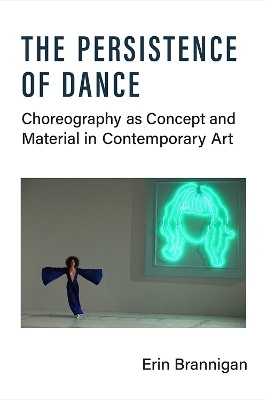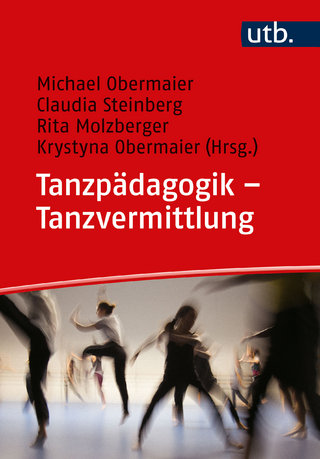
The Persistence of Dance
The University of Michigan Press (Verlag)
978-0-472-05648-4 (ISBN)
- Titel z.Zt. nicht lieferbar
- Versandkostenfrei innerhalb Deutschlands
- Auch auf Rechnung
- Verfügbarkeit in der Filiale vor Ort prüfen
- Artikel merken
There is a category of choreographic practice with a lineage stretching back to mid-20th century North America that has re-emerged since the early 1990s: dance as a contemporary art medium. Such work belongs as much to the gallery as does video art or sculpture and is distinct from both performance art and its history as well as from theater-based dance.
The Persistence of Dance: Choreography as Concept and Material in Contemporary Art explores this history by looking at the continuities and differences between the second-wave dance avant-garde in the 1950s—1970s and the third-wave starting in the 1990s. Through close readings of key artists such as Maria Hassabi, Sarah Michelson, Boris Charmatz, Meg Stuart, Philip Gehmacher, Adam Linder, Agatha Gothe-Snape, Shelley Lasica and Latai Taumoepeau, The Persistence of Dance traces the relationship between the third-wave and gallery-based work. Looking at these artists highlights how the discussions and practices associated with 'conceptual dance' resonate with the categories of conceptual and post-conceptual art as well as with the critical work on the function of visual art categories. Brannigan concludes that within the current post-disciplinary context, there is a persistence of dance and that a model of post-dance exists that encompasses dance as a contemporary art medium.
Erin Brannigan is Associate Professor of Theatre and Performance Studies at the University of New South Wales. Her book Choreography, Visual Art and Experimental Composition 1950s-1970s received the Selma-Jeanne Cohen Dance Prize.
Part I. State of the Art
Chapter 1:Unassertive Persistence: Dance Beyond Theater
Introduction
1.2 Intermedial methods for intermedial practices
1.3 Revision and specificity: choreography as a contemporary art medium
1.4 Scoping the field: across theory and practice
Case Study 1: Sarah Michelson—Choreography as Concept, Dancing as Material
Chapter 2: Intermedial Methodologies: Dance Composition and the Work of the Work
2.1 Introduction
2.2 Poetics as method
2.3 Writing dancing
2.4 The limit features of dance’s social condition (part 1)
Mind-body
Singularity/collectivity
Presence/participation
Process
Practice
Composition
Performance
2.5 Conclusion
Part II. Dance and the Museum
Case Study 2: Meg Stuart and Bart De Baere—Choreography and/as Collaboration
Chapter 3: The Museum and Dance Since the 1990s
3.1 Introduction
3.2 The resistance of dance
3.3 Curation since the 2000s: revision, appropriation, and potential
3.4 Exhibiting dance, now and then: exclusions and specificities
3.5 Conclusion
Case Study 3: Curation as Choreography—Copeland’s Choreographing
(2007)
Case Study 4: Activating Dancer Agency in the Gallery—Adrian Heathfield’s
Ghost Telephone (2016)
Case Study 5: Artist-Led Events—Shelley Lasica and Zoe Theodore,
To Do / To Make
Part III. Between the Twentieth and Twenty-First Centuries
Chapter 4: Between the Second- and Third-Wave Dance Avant-Garde
4.1 Introduction
4.2 Conceptual dance and the third-wave dance avant-garde
4.3 Continuity between recent experimental dance and the post-war neo-avant-garde
or Neo-Dada
4.4 Conclusion
Case Study 6: Boris Charmatz—Institutional Critique and Contemporary Dance Histories
Chapter 5: Choreography as Concept and Post-Disciplinarity
5.1 Introduction
5.2 Dancing versus choreography
5.3 Choreography as concept
5.4 Conclusion
Part IV: Concept and Material
Case Study 7: Adam Linder—Dance as a Contemporary Art Medium
Chapter 6: TheConceptual–Material Bind in Dance and Visual Art
6.1 Introduction
6.2 Conceptual work in dance and visual art
6.3 The persistence of a thing called dance
6.4 Conclusion
Chapter 7: The Limit Features of Dance’s Social Condition (part 2)
7.1 Introduction
7.2 Breath
7.4 Tone
7.5 Movement
7.6 Force/Energy/Effort
7.7 Rhythm
7.8 Space-time
7.9 Conclusion
Case Study 8: Shelley Lasica—Context and Process
Case Study 9: Maria Hassabi—Between Sensation and Its Display
Part V: Beyond Dancing in the Gallery
Case Study 10: Agatha Gothe-Snape—Art as Gesture
Chapter 8: The Persistence of Dance at the Point of Its Disappearance
8.1 Introduction
8.2 The material genealogy of dance
8.3 Post-dance
8.4 Conclusion
Case Study 11: Latai Taumoepeau—Dancing Moana, Working with Urgency
Conclusion: Persistent Resistance
Bibliography
| Erscheinungsdatum | 08.12.2023 |
|---|---|
| Zusatzinfo | 13 figures |
| Verlagsort | Ann Arbor |
| Sprache | englisch |
| Maße | 152 x 229 mm |
| Gewicht | 272 g |
| Themenwelt | Kunst / Musik / Theater ► Kunstgeschichte / Kunststile |
| Kunst / Musik / Theater ► Theater / Ballett | |
| Sachbuch/Ratgeber ► Sport ► Tanzen / Tanzsport | |
| Geisteswissenschaften ► Geschichte ► Hilfswissenschaften | |
| ISBN-10 | 0-472-05648-4 / 0472056484 |
| ISBN-13 | 978-0-472-05648-4 / 9780472056484 |
| Zustand | Neuware |
| Haben Sie eine Frage zum Produkt? |
aus dem Bereich


